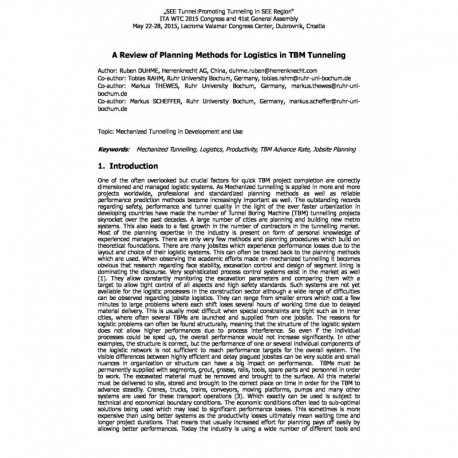Cart
0
0
No document
0,00 €
Total
Document successfully added to your shopping cart
Quantity
Total
There are 0 items in your cart.
There is 1 item in your cart.
Total documents
Total shipping
To be determined
Total
Search & filter
Search for a publication
Search & filter
Viewed documents

A Review of Planning Methods for Logistics in TBM Tunneling
wtc2015_full_duhme-2
M. Thewes / R. Duhme / T. Rahm / M. Scheffer
One of the often overlooked but crucial factors for quick TBM project completion are correctly dimensioned and managed logistic systems. As Mechanized tunnelling is applied in more and more projects worldwide, professional and standardized planning methods as well as reliable performance prediction methods become increasingly important as well. The outstanding records regarding safety, performance and tunnel quality in the light of the ever faster urbanization in developing countries have made the number of Tunnel Boring Machine (TBM) tunnelling projects skyrocket over the past decades. A large number of cities are planning and building new metro systems. This also leads to a fast growth in the number of contractors in the tunnelling market. Most of the planning expertise in the industry is present on form of personal knowledge of experienced managers. There are only very few methods and planning procedures which build on theoretical foundations. There are many jobsites which experience performance losses due to the layout and choice of their logistic systems. This can often be traced back to the planning methods which are used. When observing the academic efforts made on mechanized tunnelling it becomes obvious that research regarding face stability, excavation control and design of segment lining is dominating the discourse. Very sophisticated process control systems exist in the market as well [1]. They allow constantly monitoring the excavation parameters and comparing them with a target to allow tight control of all aspects and high safety standards. Such systems are not yet available for the logistic processes in the construction sector although a wide range of difficulties can be observed regarding jobsite logistics. They can range from smaller errors which cost a few minutes to large problems where each shift loses several hours of working time due to delayed material delivery. This is usually most difficult when special constraints are tight such as in inner cities, where often several TBMs are launched and supplied from one jobsite. The reasons for logistic problems can often be found structurally, meaning that the structure of the logistic system does not allow higher performances due to process interference. So even if the individual processes could be sped up, the overall performance would not increase significantly. In other examples, the structure is correct, but the performance of one or several individual components of the logistic network is not sufficient to reach performance targets for the overall system. The visible differences between highly efficient and delay plagued jobsites can be very subtle and small nuances in organization or structure can have a big impact on performance. TBMs must be permanently supplied with segments, grout, grease, rails, tools, spare parts and personnel in order to work. The excavated material must be removed and brought to the surface. All this material must be delivered to site, stored and brought to the correct place on time in order for the TBM to advance steadily. Cranes, trucks, trains, conveyors, moving platforms, pumps and many other systems are used for these transport operations [3]. Which exactly can be used is subject to technical and economical boundary conditions. The economic conditions often lead to sub-optimal solutions being used which may lead to significant performance losses.


